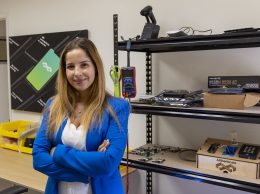Calient snags $27M amid bandwidth boom
IN THIS ARTICLE
- Technology Topic
- Stephen Nellis Author
By Stephen Nellis Friday, July 26th, 2013
Santa Barbara-based photonics firm Calient Technologies has raised $27 million in venture capital and hired a new chief financial officer to lead growth.
The latest funding round brings Calient’s total raised over the past two years to $46.4 million.
Calient’s core technology is what are called micro electromechanical devices — MEMs for short. On a single silicon chip, the company can make hundreds of tiny mirrors. Those mirrors swing on two hinges, giving them the freedom to rotate in almost any direction, beaming light-based data signals with extremely high speed.
Exploding user demand for online video from firms such as Netflix, YouTube and Hulu is driving a huge demand for bandwidth, both in Internet networks that get data to users and within the massive data centers that store, process and serve up that data. Calient is helping meet that demand with products that help data centers communicate internally and are indifferent to whatever coding language the data center’s servers happen to be talking to each other.
“It can handle hundreds of gigabytes of data on each board, irrespective of what the protocol is. We switch pure light,” said CEO Atiq Raza.
Calient was founded in 2000 with technology from UC Santa Barbara during the first big Internet bandwidth crunch. Networks got built up, but the one-two punch of the dot-com bust and the post-9/11 recession drastically reduced the pressure on them, and electronics-based gear proved good enough. For nearly a decade, Calient maintained a small but steady customer base among telecommunications giants such as AT&T and Verizon. Its switches handle pan-Pacific Internet traffic at the undersea cable landing site in Pismo Beach, for example.
But with the advent of cloud storage and processing and online video, the bandwidth crunch is on again. And this time Calient has drastically reduced its price.
Photonics use beams of laser-generated light to communicate, giving them far greater speed than electronics. Traditionally, they have been more expensive than electronics, only making them economical for the most intensive uses, like telecommunications switches.
But Calient reworked all the electronic systems around its light-switching chips and completely re-worked the control algorithms. The result is a technology that can handle more bandwidth than electronics at per-gigabit prices that are actually cheaper than electronics, Raza said. With an product that meets economic requirements, Calient is free to tout its other features — such as a the fact that it eats less than half of the power of electronic devices and doesn’t generate as much heat. Heat and cooling are typically the two biggest ongoing expenses in a data center.
“Data centers are cumulatively becoming almost 20 percent of the total power consumption for our country,” Raza said. “You’re talking about a gigantic scale. A third of that power is dedicated to supplying power and cooling.”
Since rolling out the new products, the company has experienced rapid growth that led to the need for a chief financial officer to help oversee the deployment of all the new capital. The company hired Jag Setlur, who most recently worked at July Systems, where he served as chief operating officer and CFO. Prior to that, Setlur served as CFO for Cotendo and a range of other firms.
Raza said he expects Setlur to be deeply involved in operations as the company expands its customer base and works to meet demand. Setlur told the Business Times that the company has a headcount of nearly 100.
“We are ramping up our manufacturing activity,” Setlur said. “We’ve added an additional shift, as well as keeping up our R&D function.”
Right now, Calient is selling its products directly to data center makers who want the latest and greatest. Raza said big manufacturers often look for validation among those players before seeking to license or buy a technology for integration into their own products.
“So far we’ve been selling directly to the companies that are building the data centers. The best and most enterprising of the end customers are always the first to move. Once we prime that pump, then the OEMs move,” Raza said.
Related Articles
 Friday, September 30th, 2022
Friday, September 30th, 2022











